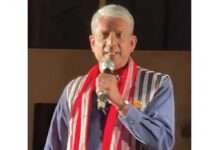[ CI Mannou ]
It is said that every story has a bitter past, involving sacrifices and hard living. Such stories are written after years of patience.
This is the story of a fascinating trip to Tamu, in Myanmar, in 1957, when I was in Chongkham monastery.
One day, two of our monks had planned for a religious trip to Tamu, a border town of Myanmar. I was given the chance to accompany them to carry small bags. When I informed my parents about the journey, they were happy, and gave me Rs 5 for my little expenses.
After a few days, we started our journey. We reached Manipur after a long and arduous journey. In Manipur, we could see the range of beautiful mountains, which looked like paintings in veiled shades of nature.
After halting a day in Manipur, we resumed our journey and reached Moreh, a foothill border town of India. It was inhabited by a mixed population, including Indian security forces.
After Moreh, we reached Namphalung village. Located on a plain area, Moreh was the last border village of Myanmar. It was a small village, inhabited by Tai and a small, mixed population. After Namphalung, we proceeded and finally reached our destination, Tamu.
It is a small plain town of Myanmar, inhabited by Myanmarese, Tai and Chin tribes. We stayed at Tamu for four days. During our stay in the town, we got the opportunity to attend two small religious functions arranged by two families.
Guided by monks, we visited a tiny village near the town to learn about their traditions and culture, and about the importance of the area.
During our visit to the villages, we came across deep jungles, fending off hordes of leeches. In the villages, we found the people living in poverty, without sufficient food and clothing. Houses were small but neat and clean. They led a very simple and satisfying life. They were proud of their heritage and hospitality. They were also fond of their dress, longyi (lungi in India).
The literacy rate was very poor. Monks and nuns had educated the children. Buddhism was practiced by some of the population.
The Tai people are deeply maintaining their age-old practices, such as the joint family system. They have high regard for the elderly people and are attached to the Buddha, Dhamma and Sangha. Everyone, rich and poor alike, bring offerings and food for the monks and nuns. Sometimes, gold was donated by the rich to embellish the Buddha image.
Another interesting practice is, they have faith in palmists and astrologers, who operate from the premises of the pagodas and temples. No one does anything without consulting an astrologer. They also believe in the spirit, which they worship. However, with the passage of time, now everything might have changed.
We also had the opportunity to see a sprawling neighbourhood, where some families of astrologers lived together.
This was one of the most memorable journeys in my life. My return journey was, therefore, filled with mixed emotions and the promise to go back again for more life-changing experiences. (The contributor is retired Principal, Govt. Hr. Secondary School Tezu)


